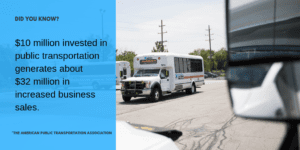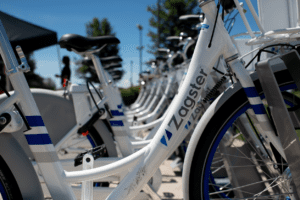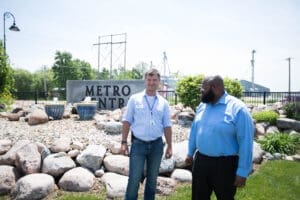Cue Kankakee: Public Transit
Following is the second installment in a series exploring how significant national economic, workforce, community development and lifestyle trends are playing out in Kankakee County, Illinois. In 2018, the Greater Chicago community was ranked the #1 metropolitan area in the United States by Area Development magazine for year-over-year growth in jobs, wages and output.
If you’re like most Americans — 76 percent, to be exact — you drive yourself to work.
This could be for any number of reasons, including the fact that more of us today have access to an automobile, and that gas prices are still far below peak levels when in 2012 the average gallon cost $3.64.
But while many counties are car dependent, data show that people still want public transportation. The percentage of riders, for example, that say they quit public transit altogether is less than 10 percent. They might ride less often, but they’re still riding.
And that’s critical for smaller communities like Kankakee County, an hour south of Chicago. While a newer generation seeks more efficient ways to get around, and as economies shift toward knowledge-based work, favoring remote workers, cities need public transit.
Step one is building it. Kankakee County (population 110,000) did that 20 years ago.
A CUSTOMER SERVICE AGENCY
As the largest public transit agency in Kankakee County, River Valley Metro has been a study in quiet reliability — so much so that it’s almost incognito for those who don’t take its roughly 900,000 rides each year.
It’s easily in the top third in efficiency among comparable public transportation systems in about 300 cities nationwide, according to federal data; and it has, since its founding in 1999, continued to expand service — not just inside Kankakee County, but outward, to University Park’s Metra station and Chicago’s Midway International Airport.
Years |
Rides via River Valley Metro |
|
1999-2003 |
721,258 |
|
2004-2008 |
2,180,729 |
|
2009-2013 |
4,392,019 |
|
2014-2018 |
4,083,680 |
While some transit agencies rely on their core demographic, River Valley is expanding its customer base — something experts say is key to a sustainable future.
CLICK IMAGE to learn more about micromobility in Kankakee County,.
River Valley is, as its managing director Rob Hoffmann likes to say, a “customer service agency.” But it’s also been a common denominator for the area’s employers, retailers, colleges and healthcare facilities, providing the area with a major economic advantage over neighboring counties.
“From Del Monte (in Kankakee) to Diversatech (in Manteno), I don’t think there are any of the major employers that we’re not serving,” Hoffmann says.
Indeed, inside the urbanized corridor of Kankakee County — Manteno, Bradley, Bourbonnais and Kankakee — 76.7 percent of the existing workforce, an estimated 30,240 jobs, is located within a half-mile of a River Valley route, according to AllTransit, a website that collects data on transit across the country.
_____________________________________
Employers and Businesses Connected by River Valley Metro Routes
CSL Behring, Kankakee Community College, Olivet Nazarene University, Riverside Medical Center, AMITA St. Mary’s Hospital, Diversatech, Del Monte, Kmart Distribution Center, Plochman’s Mustard, Urban Farmer foods, Dawn Foods
_______________________________________
According to the U.S. Census Bureau, 792 people used River Valley to regularly get to work in 2017.
Big employers will often seek out communities with an existing public transit system, says Laura Calderon, executive director of the Illinois Public Transportation Association.
“There’s a lot of data out there that shows that a successful community has a robust public transportation system.”
A SOUND INVESTMENT
When promoting public transit, industry advocates point to similar data.
The American Public Transportation Association, for example, estimates that for every $1 billion invested in transit capital and operations, 50,000 jobs are supported.
And for every $1 invested in public transportation, $4 is generated in economic return. And an investment of $10 million in public transportation generates about $32 million in increased business sales.
Other benefits of public transit include increased mobility for residents, reduction in air pollution and a reduction in congestion.
“Millennials seem to be much more conscious of th e environmental factors and the efficiency of using public transportation,” she says.
e environmental factors and the efficiency of using public transportation,” she says.
That’s important as we continue to move toward a more knowledge-based economy and mobile workforce. The APTA in 2016 released a study of so-called “innovation districts,” economic clusters that are typically transit-accessible. The study’s conclusion?
“Communities of all sizes and in all regions can attract innovation districts if they have the right mix of elements. This research shows that public transportation investment is a crucial element in creating and sustaining such districts — and to growing local and regional economies.”
The Federal Reserve Bank of Philadelphia arrived at a similar conclusion in a 2017 study: “Access to reliable transportation [is] a necessary component of economic mobility and quality of life.”
TRANSIT AS A CHOICE
But it’s a balancing act. Experts  agree that in positioning for new riders, transit agencies can’t afford to ignore their base.
agree that in positioning for new riders, transit agencies can’t afford to ignore their base.
“We think everyone has a choice,” says Scott Bogren, executive director of the Community Transportation Association of America. “Even folks who are lower income have choices.”
In 2016, TransitCenter, a public transportation advocacy group, conducted a nationwide survey to determine why people take public transportation and what motivates them to seek alternatives. They found that 32 percent of the respondents were all-purpose riders, and they made up 55 percent of all trips.
Of that group, only 4 percent were unhappy with the service they used. In other words, “captive riders” will likely find another way to get around if service gets too bad.
That same year, River Valley began a major redesign of its entire system, which is currently made up of 11 fixed routes, two commuter routes and service for people with disabilities. Part of the overhaul included turning looping routes into bi-directional routes, reducing the time it takes riders to travel back and forth. The agency also added express service along Illinois Route 50; and shortened the travel time to and from Kankakee Community College and Northfield Square mall.
Those improvements could help River Valley scale if there are major changes to transportation patterns.
“You can’t start a bus route in a day,” Hoffmann says. “So you always have to be looking way ahead.”
Bogren, of the Community Transportation Association of America, said the emergence of better data will ultimately help transit systems do a better job “asserting their value.”
“My question to them is: What happens to that rider economically when they get off the bus? How do we capture that?
[CLICK INFOGRAPHIC to view larger.]
CLICK IMAGE for more about RVM talent and careers.
We have to assert the system’s import and impact,” Bogren said.
For Hoffmann, that impact is about empowering people, whether they’re students, or elderly, or those with disabilities that keep them from driving.
“Take the bus away,” he said, “and how are they going to get a job, or an education?”
Perhaps it’s a chicken-and-egg question. Does a strong public transportation system follow or precede a resurgent community?
“It’s more about partnerships,” Hoffmann said. “Communities and transit agencies that work together — and understand each other’s priorities — thrive together.”



